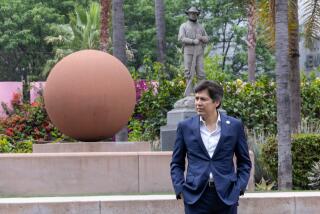Patricia Gazin; Ex-Mayor of Hermosa Beach, City Historian
- Share via
She knew that the tiny 1.3-square-mile plot once supported a thriving silk industry and, during 1920s Prohibition, was a hotbed of bootlegging and gambling.
She knew television’s Ozzie and Harriet had lived there.
And she had no trouble remembering the name of the little town’s first woman mayor--her own.
Patricia A. Gazin, self-styled historian of Hermosa Beach who was elected the city’s first woman City Council member and mayor in 1959, died Feb. 27. She was 76.
Gazin, who wrote two books about her little city, died of complications of diabetes at Beach Cities Rehabilitation Center in Redondo Beach, said her daughter, Catherine L. Gazin.
The onetime mayor, who earned her position when few women were winning any political office, helped develop new city offices, a police and fire station, a municipal pier and a new library for Hermosa Beach.
But her influence on and beyond the little beach community included more.
A bibliophile and former journalist, she founded the city’s Friends of the Library and volunteered her efforts in libraries for more than 30 years. She sat on the Los Angeles County Library Advisory Commission, and was president of the Book Collectors of Los Angeles.
Beyond her own city limits, she also served on the Los Angeles County Grand Jury and was elected president of the Los Angeles County Grand Jurors’ Assn., an alumni group that supports and promotes Grand Jury recommendations about county government.
Gazin, however, is best known as the historian of Hermosa Beach. She worked with the Hermosa Beach Historical Society from its founding in 1987, and served as a guide when it opened a museum in the city’s Community Center years later. She even contributed one of the major artifacts--the big, block letters spelling out CITY HALL, which marked the 1913 municipal building until its destruction. Gazin had kept the letters in her back yard since rescuing them in 1959.
More important, she wrote the books about her town, based on decades of poring through files of the defunct weekly newspaper--The Hermosa Beach Review--interviewing old-timers and trying to piece together spotty city records.
The first book, published in 1977, was “Castles in the Sand: An Incomplete Chronicle of Habitations of Ancient Hermosans.” Included were extensive photographs of ocean-front mansions featuring Art Deco and other architectural styles.
Her second, published in 1991 and designed and typeset by her husband, Myron, was “Footnotes on the Sand: An Incomplete Compendium, an Arbitrary Selection of Events, Rumor, Speculation, Some Fact and Some Fiction about Hermosa Beach.”
Readers interested in her city welcomed Gazin’s gossipy, conversational and colorful writing, reflected in her subtitles. As for the “Footnotes” title, she said, “Hermosa Beach is kind of a footnote city. Nothing earthshaking has happened here.”
Of Hermosa Beach’s incorporation Jan. 14, 1907, as Los Angeles County’s 19th city, Gazin wrote irreverently: “With no turbulence, little fanfare, the city was born, became of record and disturbed history not at all.”
Gazin is survived by her husband of half a century; a son, Gregory of San Diego; and a daughter, Catherine of Redondo Beach.
A memorial service is scheduled at 11 a.m. Saturday at Hermosa Beach City Hall.
The family has asked that, instead of flowers, memorial contributions be sent to the American Diabetes Assn. or the Hermosa Beach Friends of the Library.
More to Read
Sign up for Essential California
The most important California stories and recommendations in your inbox every morning.
You may occasionally receive promotional content from the Los Angeles Times.













